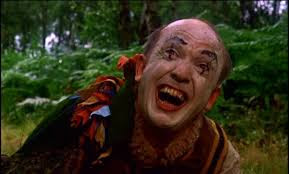War Machine is a dramatization of Michael Hastings' book about the Afghanistan war, The Operators (which expanded the 2010 Rolling Stone piece, "The Runaway General"). This film is welcome evidence Hollywood is still capable of satire (after Southland Tales, American Dreamz, The Joneses, Salvation Boulevard and Butter).
General Glen McMahon -- Brad Pitt, playing a cartoonish version of Gen. Stanley McChrystal -- seems more concerned with projecting affirmative masculinity than strictly military objectives.
It's a funny turn: ready with a buzzword, McMahon has a hilarious, stiff gait even when jogging. Brow perpetually furrowed, his hands claw for odd emphasis. But he rarely loses his temper, leaving it to a sycophantic posse.
As commander of allied forces in Afghanistan, his job isn't so much waging war as lobbying governments. As said by a German official (Tilda Swinton in a lucid cameo), careerism renders McMahon oblivious to whether American goals in the region make any sense. When a U.S. soldier vents about the surreal conflict where medals are given for "courageous restraint," the general tells him "get un-confused."
The overall tone is sadly wry. Though well-acted, some of the supporting characters smack of manipulation: the visiting wife (Meg Tilly) would be equally lonely during a necessary war; Ben Kingsley appears as the corrupt puppet-ruler of Afghanistan, but we don't see Hamid Karzai before the dubious office.
The pivotal scene is an airplane encounter between McMahon and Pat Mackinnon (Alan Ruck as a fictionalization of Ambassador Karl Eikenberry). After one-or-more drinks, Mackinnon breaks down the general's task:
When a person or group consistently fails to achieve stated goals, we should question the desire to succeed. Despite its wit and value as history, War Machine is ultimately disingenuous, in assuming American shortfalls in Korea, Vietnam and the Middle East are problematic ... for anyone other than soldiers and the host nations (the word "insanity" is prominent). The opposite may be true, in the context of U.S. global dominance and, especially, the Pentagon's yearly allowance of over $500 billion.
 |
| Brad Pitt as"MacMahon" |
General Glen McMahon -- Brad Pitt, playing a cartoonish version of Gen. Stanley McChrystal -- seems more concerned with projecting affirmative masculinity than strictly military objectives.
It's a funny turn: ready with a buzzword, McMahon has a hilarious, stiff gait even when jogging. Brow perpetually furrowed, his hands claw for odd emphasis. But he rarely loses his temper, leaving it to a sycophantic posse.
As commander of allied forces in Afghanistan, his job isn't so much waging war as lobbying governments. As said by a German official (Tilda Swinton in a lucid cameo), careerism renders McMahon oblivious to whether American goals in the region make any sense. When a U.S. soldier vents about the surreal conflict where medals are given for "courageous restraint," the general tells him "get un-confused."
The overall tone is sadly wry. Though well-acted, some of the supporting characters smack of manipulation: the visiting wife (Meg Tilly) would be equally lonely during a necessary war; Ben Kingsley appears as the corrupt puppet-ruler of Afghanistan, but we don't see Hamid Karzai before the dubious office.
The pivotal scene is an airplane encounter between McMahon and Pat Mackinnon (Alan Ruck as a fictionalization of Ambassador Karl Eikenberry). After one-or-more drinks, Mackinnon breaks down the general's task:
You're not here to win, you're here to clean up the mess ... (to) show everyone ... a nicer set of graphs. Either that, or get yourself fired.These lines, along with McMahon's lack of "face time" with the president, illuminate the casual disrespect, reported by Hastings, of those up the chain of command. Of course, President Obama soon fired McChrystal.
When a person or group consistently fails to achieve stated goals, we should question the desire to succeed. Despite its wit and value as history, War Machine is ultimately disingenuous, in assuming American shortfalls in Korea, Vietnam and the Middle East are problematic ... for anyone other than soldiers and the host nations (the word "insanity" is prominent). The opposite may be true, in the context of U.S. global dominance and, especially, the Pentagon's yearly allowance of over $500 billion.

















